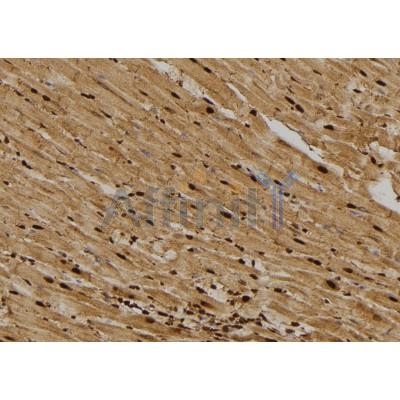CDCA8 Antibody - #DF6115
| Product: | CDCA8 Antibody |
| Catalog: | DF6115 |
| Description: | Rabbit polyclonal antibody to CDCA8 |
| Application: | WB IHC IF/ICC |
| Cited expt.: | WB, IHC |
| Reactivity: | Human, Mouse, Rat, Monkey |
| Prediction: | Pig, Bovine, Horse, Sheep, Rabbit, Dog |
| Mol.Wt.: | 31kDa; 31kD(Calculated). |
| Uniprot: | Q53HL2 |
| RRID: | AB_2838082 |
Related Downloads
Protocols
Product Info
*The optimal dilutions should be determined by the end user. For optimal experimental results, antibody reuse is not recommended.
*Tips:
WB: For western blot detection of denatured protein samples. IHC: For immunohistochemical detection of paraffin sections (IHC-p) or frozen sections (IHC-f) of tissue samples. IF/ICC: For immunofluorescence detection of cell samples. ELISA(peptide): For ELISA detection of antigenic peptide.
Cite Format: Affinity Biosciences Cat# DF6115, RRID:AB_2838082.
Fold/Unfold
BOR; BOREA_HUMAN; Borealin; CDCA8; Cell division cycle associated 8; cell division cycle associated protein 8; Cell division cycle-associated protein 8; Dasra B; Dasra-B; DasraB; FLJ10468; FLJ12042; hDasra B; hDasra-B; MESRGP; OTTHUMP00000004514; pluripotent embryonic stem cell related gene 3 protein; Pluripotent embryonic stem cell-related gene 3 protein;
Immunogens
A synthesized peptide derived from human CDCA8, corresponding to a region within N-terminal amino acids.
- Q53HL2 BOREA_HUMAN:
- Protein BLAST With
- NCBI/
- ExPASy/
- Uniprot
MAPRKGSSRVAKTNSLRRRKLASFLKDFDREVEIRIKQIESDRQNLLKEVDNLYNIEILRLPKALREMNWLDYFALGGNKQALEEAATADLDITEINKLTAEAIQTPLKSAKTRKVIQVDEMIVEEEEEEENERKNLQTARVKRCPPSKKRTQSIQGKGKGKRSSRANTVTPAVGRLEVSMVKPTPGLTPRFDSRVFKTPGLRTPAAGERIYNISGNGSPLADSKEIFLTVPVGGGESLRLLASDLQRHSIAQLDPEALGNIKKLSNRLAQICSSIRTHK
Predictions
Score>80(red) has high confidence and is suggested to be used for WB detection. *The prediction model is mainly based on the alignment of immunogen sequences, the results are for reference only, not as the basis of quality assurance.
High(score>80) Medium(80>score>50) Low(score<50) No confidence
Research Backgrounds
Component of the chromosomal passenger complex (CPC), a complex that acts as a key regulator of mitosis. The CPC complex has essential functions at the centromere in ensuring correct chromosome alignment and segregation and is required for chromatin-induced microtubule stabilization and spindle assembly. Major effector of the TTK kinase in the control of attachment-error-correction and chromosome alignment.
Phosphorylated by TTK, essentially at Thr-88, Thr94, Thr-169 and Thr-230. Phosphorylation (probably by CDK1) promotes targeting of the CPC to centromeric DNA.
Sumoylated by UBE2I and RANBP2. Desumoylated by SENP3 through the removal of SUMO2 and SUMO3.
Nucleus>Nucleolus. Cytoplasm. Cytoplasm>Cytoskeleton>Spindle. Chromosome>Centromere.
Note: Localizes on chromosome arms and inner centromeres from prophase through metaphase and then transferring to the spindle midzone and midbody from anaphase through cytokinesis. Colocalizes with SENP3 in the nucleolus in interphase cells.
The C-terminal region (aa 207-280) represents the dimerization motif.
Belongs to the borealin family.
References
Application: WB Species: human Sample: HGSOC and FT tissues
Application: IHC Species: human Sample: tumor
Restrictive clause
Affinity Biosciences tests all products strictly. Citations are provided as a resource for additional applications that have not been validated by Affinity Biosciences. Please choose the appropriate format for each application and consult Materials and Methods sections for additional details about the use of any product in these publications.
For Research Use Only.
Not for use in diagnostic or therapeutic procedures. Not for resale. Not for distribution without written consent. Affinity Biosciences will not be held responsible for patent infringement or other violations that may occur with the use of our products. Affinity Biosciences, Affinity Biosciences Logo and all other trademarks are the property of Affinity Biosciences LTD.





